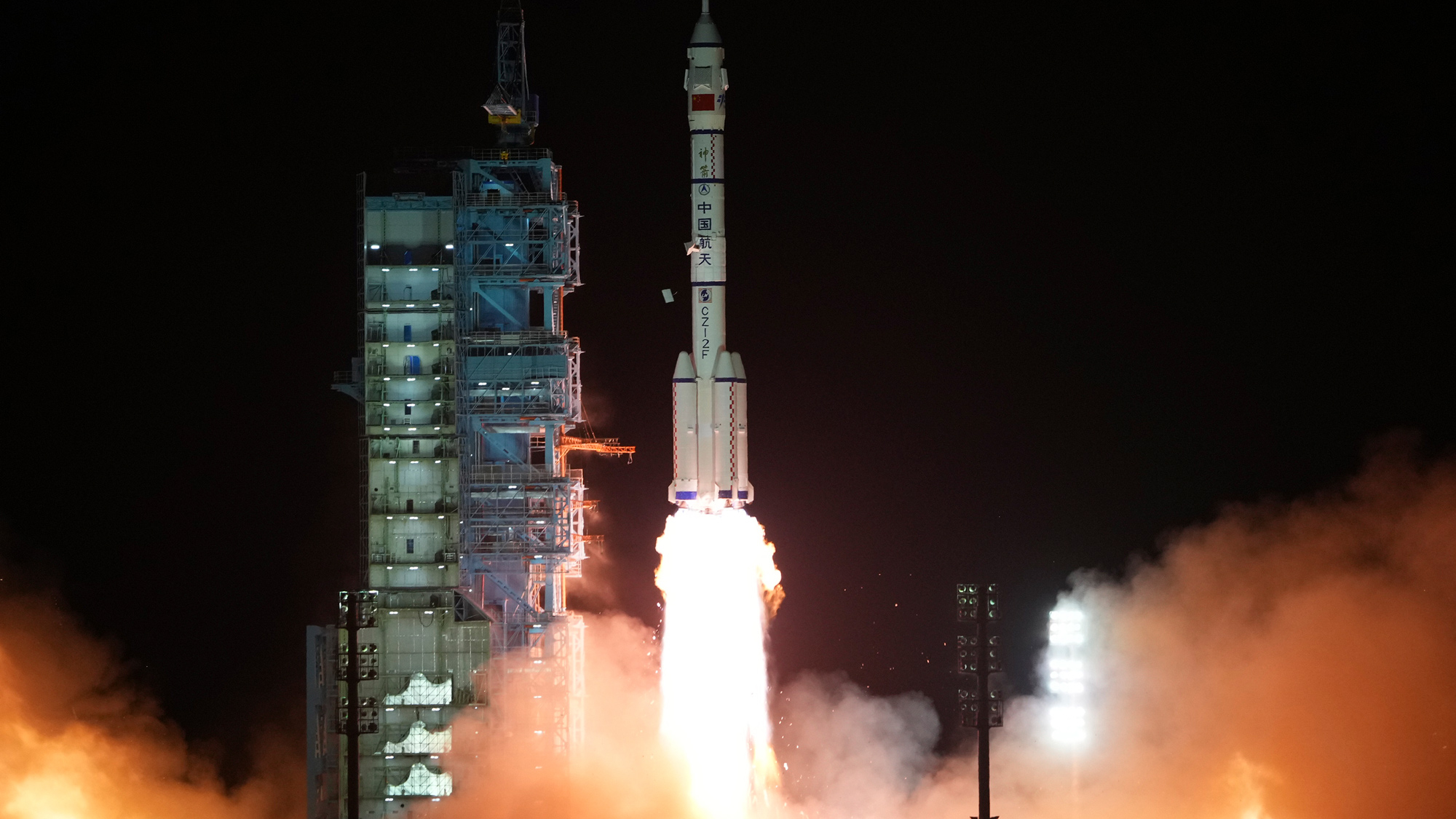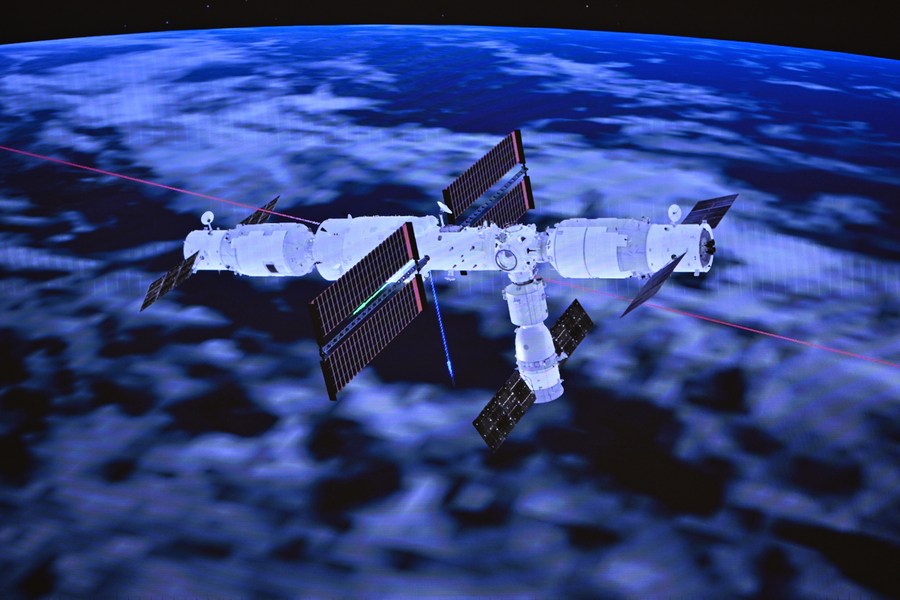
The manned spaceship Shenzhou-15, atop the Long March-2F Y15 carrier rocket, blasts off from Jiuquan Satellite Launch Center in northwestern China, November 29, 2022. /Xinhua
The manned spaceship Shenzhou-15, atop the Long March-2F Y15 carrier rocket, blasts off from Jiuquan Satellite Launch Center in northwestern China, November 29, 2022. /Xinhua
Editor's note: Yang Yuguang is vice chair of the Space Transportation Committee of the International Astronautical Federation. The article reflects the author's opinions and not necessarily the views of CGTN.
As China's Tiangong space station finished the formation of its T-shape structure, some might wonder if this marked the completion of the station's construction. No, there is one last task in the construction phase: The Shenzhou-15 crewed spaceflight mission was launched on November 29.
Subsequently, three taikonauts, aboard the Shenzhou-15, conduct a work handover with the Shenzhou-14 crew in orbit. At the moment when the Long March-2F Y15 carrier rocket separates with the Shenzhou-15 spaceship, for the first time there are six Chinese taikonauts in orbit. This is a remarkable moment not only for China but the whole world.
The in-orbit hand-over was started during the flight of the MIR space station of the former Soviet Union, and the International Space Station always conducts a hand-over of different expedition teams in this method.
For China, it is the right moment to do this. It is not only highlight of China's space activity, but very necessary. We know that the purpose of building a space station is to do scientific research and engineering research. With manned space technology increasingly practical, the scientific experiments have become more complex; in many cases, the experiments can not be accomplished by one expedition team alone.
To hand over the tasks in a face-to-face style will be the most efficient way. But this also raises a strict requirement for the design of the space station. China's space station adopted a re-generative environmental control and life support system, which is complex considering its status to support three taikonauts differs from that to support six taikonauts.
Shenzhou-15 crew will unlock 15 racks dedicated to scientific research. During the six-month long mission, they will conduct scientific experiments designed by not only Chinese scientists but their foreign counterparts. China manned space agency and United Nations Office for Outer Space Affairs have called for experiments from all over the world. Until now nine experiments from 17 countries has been selected and these experiments will be done by Chinese astronauts, probably Shenzhou-15 crew or the future crews.
International cooperation is an important factor of China's manned space program. The European Space Agency has supported China's early manned missions with its ground stations all over the world. During the Shenzhou-8 unmanned mission, there was joint biological experimental equipment called SIMBOX. 17 joint experiments were conducted by China and Germany. Sooner or later, we will see foreign taikonauts visit China's space station by Shenzhou spaceships.

A view of China's Tiangong space station, June 5, 2022. /Xinhua
A view of China's Tiangong space station, June 5, 2022. /Xinhua
The higher-level cooperation will be the visit of foreign spacecrafts, either a manned spaceship or a cargo spacecraft, to China's space station, which is achievable from the technological perspective since China's space station adopted the APAS docking mechanism, similar to those used by other countries.
If another country's spacecraft wants to visit the Tiangong space station, it only needs some small adjustments, for instance, to install China's microwave radar, LIDAR for rendezvous and docking, and follow China's docking procedure. We hope this can also be realized.
The highest-level international cooperation will be on a module-level. In the future, the Tiangong space station will be expanded. A second core module will be connected to the station, which has additional docking ports and berthing ports. Therefore, it is capable to have another scientific research module made by foreign countries and get connected to the station as a permanent part.
China recognizes its space station not only as a national laboratory in outer space, but an important platform for international cooperation. Moreover, China recognizes international cooperation as essential criteria for evaluating a country's level of development in the space field.
Besides the international cooperation in manned space program, China will also have more and more international payloads on its Chang'e lunar probes. This kind of payloads has been chosen for the Chang'e-6 lunar-sample-return mission in 2025. And call for intentional payload of the Chang'e-7 mission has started.
The international lunar research station will be built near the south pole of the Moon. China has suggested all space-capable nations to build infrastructure in the cislunar space. Of course, the international lunar research station will first be a robotic one, but China also has its manned lunar program, and the final purpose is to build a permanent base on the lunar surface. We believe that Chinese taikonauts will likely walk on the Moon before 2030, and there will be more opportunities to build the lunar base with other countries.
For all space-capable nations, an important destination is manned mission to Mars. Even for a single trip to Mars and back, the cost will be greater than those invested in international space station program. Therefore, international cooperation, where China will play a crucial role, is essential to achieve this goal. This will benefit our country, as well as the whole world.
(If you want to contribute and have specific expertise, please contact us at opinions@cgtn.com. Follow @thouse_opinions on Twitter to discover the latest commentaries on CGTN Opinion Section.)